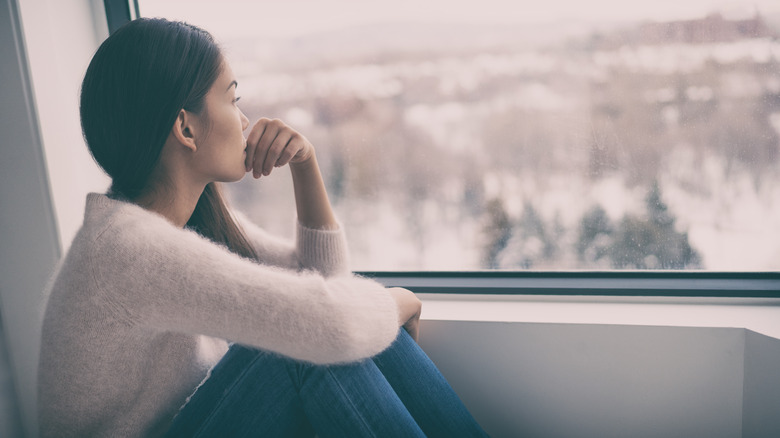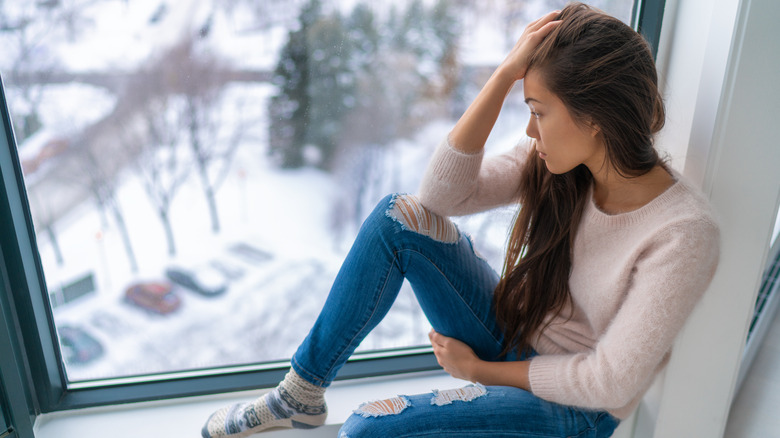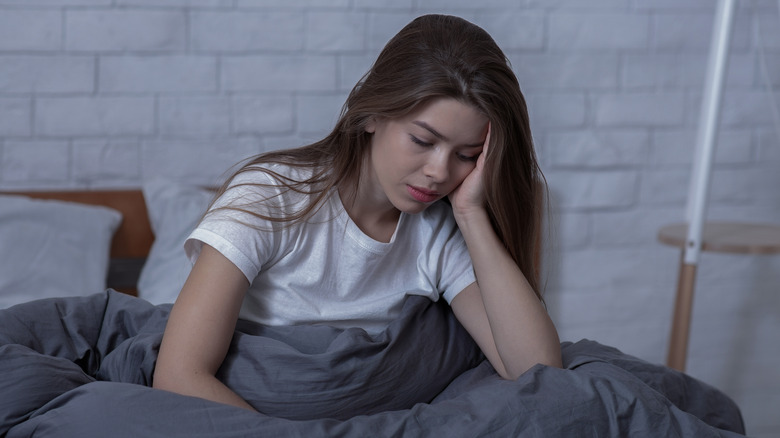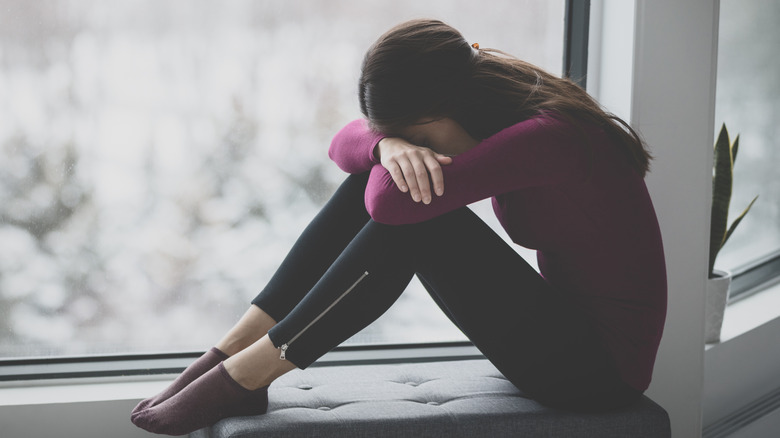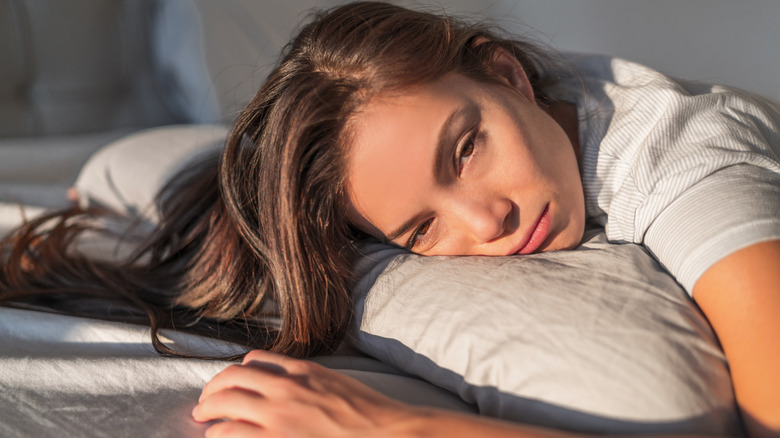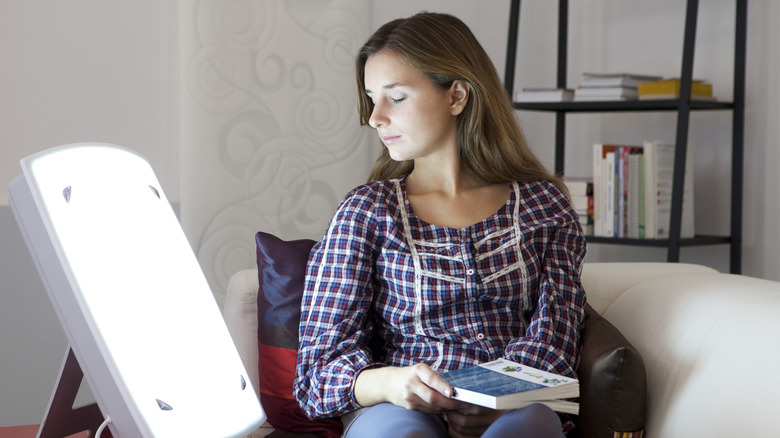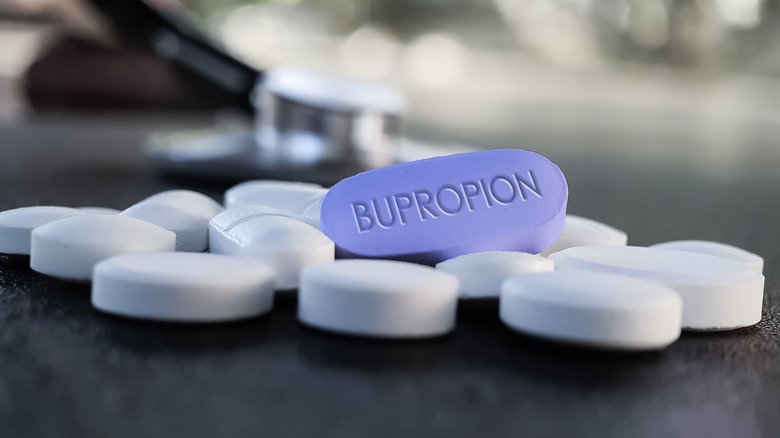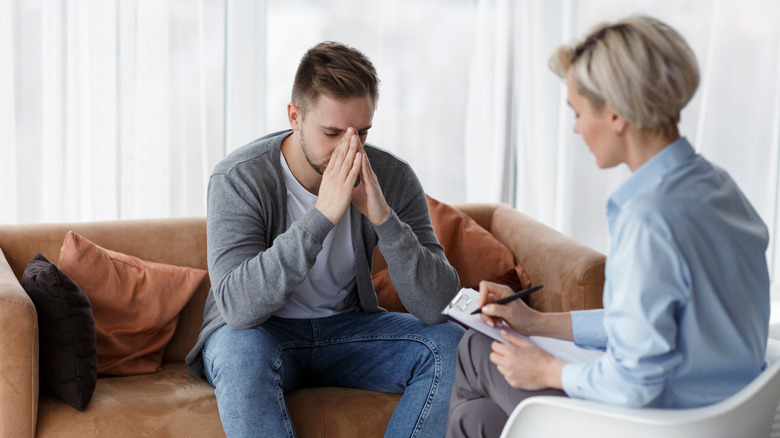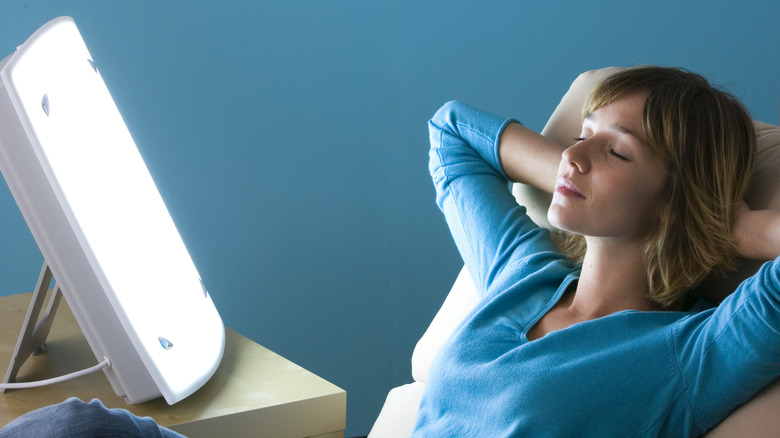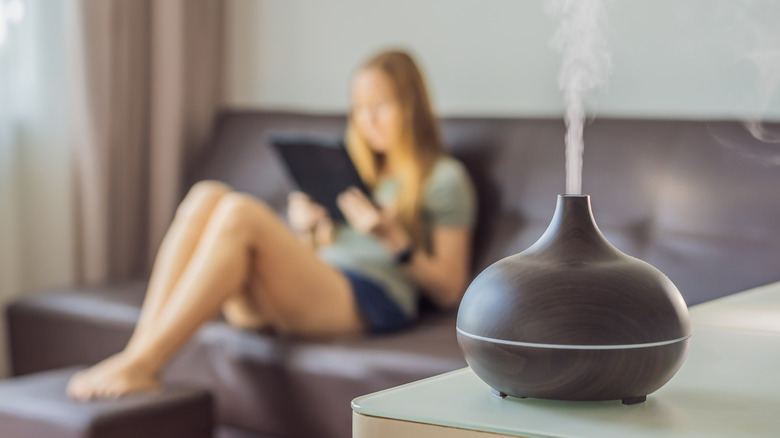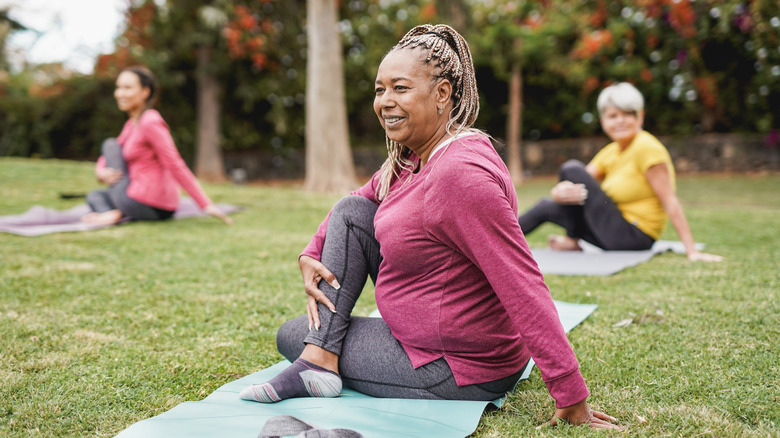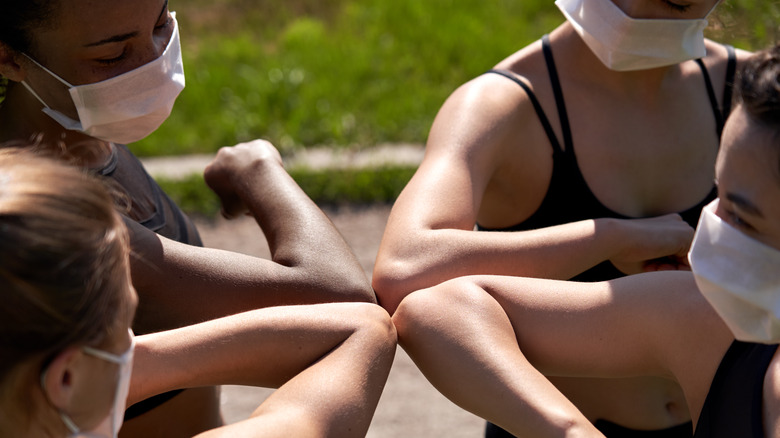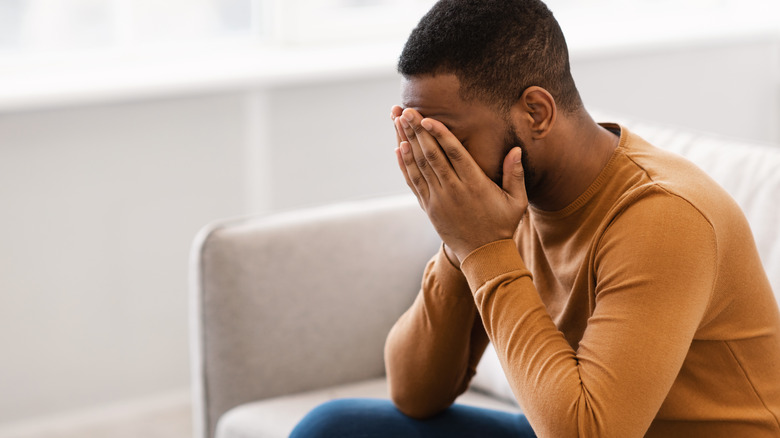Everything You Need To Know About Seasonal Affective Disorder
Seasonal affective disorder, often referred to as SAD, is depression that occurs in response to seasonal transitions. According to the National Institute of Mental Health (NIMH), SAD isn't considered it's own depressive disorder but a subtype of depression. It's characterized by an onset of symptoms around the same time every year at the change of the seasons. The symptoms usually last for about four or five months and then go into remission as the seasons change again.
The majority of people with SAD have winter-pattern SAD, or winter depression. Their symptoms typically start in the late fall and intensify through the winter months. People with winter-pattern SAD usually start to feel better in the spring, and their depression stays in remission through the summer. However, seasonal affective disorder isn't limited to the winter months. Some people experience summer-pattern SAD, or summer depression. Their symptoms start in the late spring and start to let up in the fall. Summer-pattern SAD is far less common than winter-pattern SAD.
The symptoms of SAD
Because SAD is a subtype of depression, many of the symptoms are the same, per NIMH. The hallmark symptom of both depression and SAD is feeling down nearly every day, for the majority of the day, for longer than two weeks at a time. You may also feel an overpowering sense of hopelessness or worthlessness. Many people experience overwhelming fatigue and lose interest in the things that used to bring them joy. It's also common to be easily irritated and to have a hard time concentrating or forming thoughts. Thoughts of self-harm or suicide may also accompany depression or SAD. If you start to experience these thoughts, seek professional attention immediately.
A few additional symptoms are common with winter-pattern SAD. Many people find themselves sleeping a lot more than normal but not feeling refreshed by adequate rest. Another common symptom is overeating carbohydrates, which can lead to weight gain. A sense of "hibernation" is also prevalent. You might feel like withdrawing from your friends and family and avoiding social situations.
The symptoms of summer-pattern SAD are essentially the opposite of the symptoms of winter-pattern SAD. Instead of being extremely tired, many people with summer depression have trouble sleeping at all and feel restless, agitated, and anxious much of the time. Instead of gaining weight from carb cravings, they tend to lose weight due to loss of appetite. Sometimes people with summer-pattern depression can struggle with violent outbursts.
If you or someone you know is struggling with mental health or suicidal thoughts, please contact the Crisis Text Line by texting HOME to 741741, call the National Alliance on Mental Illness helpline at 1-800-950-NAMI (6264), visit the National Institute of Mental Health website, or call the National Suicide Prevention Lifeline at 1-800-273-TALK (8255).
Is it the winter blues or seasonal affective disorder?
Feeling down in the late fall or winter months is a common phenomenon, often called "the winter blues" (via the Cleveland Clinic). However, seasonal affective disorder isn't just the winter blues. If you feel like you're in a rut and just can't get out for more than two weeks at a time, it's important to seek medical attention. SAD is a legitimate depressive disorder that requires specific treatment administered by a professional.
According to Tufts Medical Center, many people experience "the winter blues" because of the lifestyle changes that happen during the winter, especially in cold climates. Many people spend more time inside, exercise less, and overeat during the winter, all of which can lead to a depressed mood. If making some simple lifestyle changes — like getting outside for a bit every day, getting more regular exercise, or adjusting your diet — changes your mood, then you probably have a case of "the winter blues," not SAD. Another good way to tell the difference is to assess how your symptoms are impacting your daily life. "The winter blues" can make it hard to accomplish daily tasks, but it's not debilitating. If any of the previously mentioned symptoms of depression are preventing you from functioning normally, that's not "the winter blues," and you should see a doctor to be evaluated for SAD.
Causes of seasonal depression
According to an article in American Family Physician, experts on seasonal affective disorder generally agree that there is no single cause of the disorder and that it results from a combination of biological factors. One of the biggest contributing factors in both forms of SAD is the change in the amount of daylight. According to the NIMH, research has shown that sunlight helps regulate both serotonin and melatonin. Serotonin plays a major part in mood regulation, and melatonin is one of the hormones responsible for regulating our sleep patterns. Research shows that people with SAD aren't able to produce these chemicals in the proper amounts. So, when the amount of daylight changes and their chemical production is disrupted, they end up with a serotonin deficiency and an overproduction of melatonin, the perfect chemical combination for seasonal depression.
Another study published in Depression Research and Treatment found that people with lower levels of Vitamin D were more likely to exhibit seasonal symptoms of depression, which is consistent with other studies on Vitamin D deficiency and SAD. Since our biggest source of Vitamin D is exposure to sunlight, Vitamin D deficiencies are more likely to develop in the winter because we're not outside as much. Finally, studies have also shown a genetic component to SAD. Research done on families, especially on identical twins, have shown that if one person in the family has SAD, others in the family are more likely to have it as well (via Translational Psychiatry).
Who's at Risk for SAD?
In the U.S., about 5% of the adult population struggles with seasonal affective disorder, per the Cleveland Clinic. About 75% of the people affected by SAD are female, but research hasn't yet determined why the prevalence is so much higher in women. The onset of SAD usually happens in young adulthood, but it can impact people of all ages. According to an article on SAD in the journal Alternative and Complementary Therapies, between 2% and 5% of children ages 9-19 experience symptoms of seasonal depression.
People who have known issues with serotonin deficiency, melatonin production, or Vitamin D deficiencies are at higher risk for seasonal depression, as are those who have family members with SAD. People who have other mental illnesses like depression, bipolar disorder, and schizophrenia are also at greater risk (via Cleveland Clinic).
Living in a particularly cloudy place or an area in a higher latitude also puts you at greater risk because these places get even less sunlight during the winter than other locales. Indeed, according to an article in Psychiatric Times, one study found that only 1% of people in Sarasota, Florida experience seasonal depression while more than 9% of people in Nashua, New Hampshire struggle with SAD.
Treatment options for seasonal affective disorder
Luckily, there are several effective treatment options for seasonal depression, with the most common being antidepressant medications, talk therapy, and light therapy.
There are a few medication options for seasonal affective disorder. The FDA has only approved one medication, Wellbutrin (Bupropion), specifically for SAD, per the NIMH. However, selective serotonin reuptake inhibitors (SSRIs) are also effective. You can work with your doctor to determine which type of medication is best for you. Talking to a therapist, especially one who specializes in cognitive behavioral therapy (CBT), is also helpful for many people. Some people see therapists year-round, while others only work with one when they're experiencing SAD symptoms. Finally, light therapy involves daily exposure to a special kind of very bright light via a light box first thing in the morning. For best results, the exposure should last at least 20 minutes. Many people find that a combination of these therapies works best.
How do medications help with SAD?
According to the Mayo Clinic, SSRIs treat depression by increasing the amount of serotonin in the brain. Since seasonal depression is linked to serotonin deficiencies, SSRIs are a particularly effective treatment. Commonly prescribed SSRIs include Prozac (fluoxetine), Celexa (citalopram), Zoloft (sertraline), Paxil (paroxetine), and Lexapro (escitalopram). Though these medications are not specifically designed for SAD, they are very effective at treating depression, and many people with SAD find they work well.
Wellbutrin (Bupropion) works a little differently because it's not an SSRI. According to Medical News Today, Wellbutrin is a norepinephrine-dopamine reuptake inhibitor (NDRI), which means that it boosts the levels of dopamine in your brain instead of the levels of serotonin. The trials that were done during the FDA approval process found that 84% of patients who took Wellbutrin were no longer experiencing SAD symptoms at the end of the trials (per WebMD). A follow-up study found that taking Wellbutrin in the fall, before the onset of SAD symptoms, could lessen the severity of the seasonal depression (via Biological Psychiatry). All medications have side effects, so be sure to discuss your options with your doctor.
How does talk therapy help with SAD?
According to Psychology Today, cognitive behavioral therapy (CBT) is a type of talk therapy that focuses on identifying negative thought patterns and behaviors and learning to challenge them. CBT also teaches patients how to overcome these negative thought patterns and behaviors by replacing them with more realistic thought patterns and healthier behaviors.
Clinicians treating people with seasonal affective disorders have developed a specific kind of therapy specifically for SAD called CBT-SAD. This method combines the traditional techniques of CBT with another technique called behavioral activation. This technique focuses on helping patients figure out things that make them happy during the winter and developing a plan for how they'll implement those activities in their lives. One study found that CBT-SAD is just as effective as light therapy after the first year of treatment (via American Journal of Psychiatry). The same study found that after a second year of treatment, patients who underwent CBT-SAD therapy had fewer recurrences of their seasonal depression symptoms. This suggests that the impacts of CBT-SAD therapy may be more long-lasting than the impacts of light therapy. That said, another study found that during an acute depressive event, light therapy and CBT-SAD were equally effective in improving symptoms.
How does light therapy work for SAD?
According to Harvard Health, light therapy works by simulating the sunlight that we're missing out on in the winter. Light exposure first thing in the morning helps the hypothalamus regulate your circadian rhythm, the internal mechanism that tells us when to go to wake up and when to go to sleep. When this system is dysregulated, it can lead to depression. So, resetting your circadian rhythm with artificial light can reduce symptoms of SAD.
A lot of research has been done into the effectiveness of light therapy. A meta-analysis of studies on the effectiveness of light therapy found that "a significant reduction in depression symptom severity was associated with bright light treatment" (via The American Journal of Psychiatry). Another study found that patients who tried light therapy experienced a significant reduction in symptoms almost immediately by using the therapeutic light between 20 and 40 minutes a day (via International Journal on Disability and Human Development).
Alternative treatments for SAD
There are also several alternative treatments for SAD including supplements, meditation, and aromatherapy. According to NIMH, many people with SAD have Vitamin D deficiencies, so adding a Vitamin D supplement to their daily routine can help reduce SAD symptoms. The Omega Institute, a holistic medicine education program in the United States, suggests that St. John's wort may help as well. Adding supplements should only be done under the supervision of your medical team.
Additionally, a meta analysis of several studies found that aromatherapy both improved mood and reduced symptoms of SAD. The Omega Institute states that different scents can boost your mood in different ways. If you want to calm anxiety, try frankincense or lavender. If you need some energy, basil, peppermint, or grapefruit can do the trick.
Extensive research has also established that meditation can help reduce the symptoms of depression (via Harvard Health). In fact, new research suggests that meditation may even rewire the brain, improving depression symptoms. Several different forms of meditation have proven helpful, so people with SAD can choose the method that they're most comfortable trying.
How regular exercise helps with SAD
When you're depressed, exerting yourself to exercise may feel impossible. However, regular exercise is one of the best ways to manage depression of any kind. Allina Health explains that exercise releases endorphins, which boost your mood, and kicks your metabolism into gear, which improves your energy levels. Regular exercise also helps you sleep better. This is essential for people with seasonal affective disorder, since they often deal with intense fatigue.
Though any exercise can help relieve SAD symptoms, gentle activities like yoga, tai chi, walking, and swimming may be most effective For people who like to get more intense with their workouts, running and strength training are also good choices. Getting outside on a sunny day for a bit of movement will double the impact of your exercise because you'll be getting some sunshine as well. Researchers at the University of Vermont have found that participation in a winter sport like skiing, snowboarding, snowshoeing, or hockey can help with SAD as well.
If the thought of starting an exercise program is overwhelming, no worries! As little as 10 minutes of exercise per day can improve seasonal depression symptoms (via Allina Health). And busting your butt cleaning the house totally counts.
Staying social is important
Research has long shown a connection between isolation and several mental health issues including depression, per the American Psychological Association. Unfortunately, isolating is one of the symptoms of seasonal affective disorder (via NIMH), which makes it hard to maintain connections with family and friends or participate in social activities. This kicks off a nasty cycle: isolation makes your depression worse but your depression makes you isolate.
The only way to break this cycle is to stay connected with other people, Dr. Arlene Malinowski told Everyday Health. Malinowski, who has SAD herself, recommends preparing for your tough season by lining up a slate of fun activities, particularly ones that are social in nature. Psychologist Kim Burgess seconds this approach, with the reminder that FaceTime is a good way to connect over long distances, when the weather makes it tough to do anything outdoors, or if you aren't able to do a COVID-safe in-person hang (via Everyday Health). So when you know the seasonal blues are coming on, set up a regular walking date with a bestie, join a book club, or put a Zoom call with friends on the calendar — these social connections will help boost your mood.
Food and SAD
According to the Cleveland Clinic, what you eat can impact your depression symptoms as well. When you eat carbs and sugar, your brain releases serotonin. Since one of the causes of SAD is serotonin deficiency, your brain may create cravings for simple carbs and sugar. However, these foods aren't the solution to your seasonal depression. Instead, choose complex carbs and proteins. Foods with complex carbs include whole grain bread, potatoes, brown rice, oats, whole grain pasta, quinoa, fruits, vegetables, and beans. Pair these foods with lean proteins like fish, skinless white meat chicken, beef, pork or seafood. If you're a vegetarian, load up on eggs, beans, and nuts. Mixing complex carbs with proteins at each meal and snack will keep you satisfied, which can help keep cravings at bay. This combo also helps keep you energized throughout the day, which is important when SAD makes you feel like you're dragging.
One easy way to create a balanced meal is to put together a colorful plate. If your entire plate is white or brown — like white meat chicken with mashed potatoes and rice — you can add some colorful fruits or vegetables to balance out the meal.
Lifestyle changes that can help
Making some simple lifestyle changes can also help with SAD. According to Everyday Health, sticking to a consistent daily routine is important. Waking up and going to bed at the same time each day ensures that you're exposed to light for a similar amount of time, and will help regulate your sleep/wake cycle, which is crucial for managing SAD. Make sure that you add things you enjoy into your daily routine as well, or plan a vacation or staycation to get in some fun and relaxation time.
According to WebMD, journaling is another great practice for those with SAD. Writing down how you're feeling on a daily basis can make you more aware of your negative thoughts. It can also help you identify patterns that you've fallen into during your depression. This can give you a sense of control over your SAD. Journaling is also a good release at a time when you might be tempted to push down your thoughts and feelings.
Remember to be gentle with yourself during these times as well. John Hopkins Medicine suggests that adjusting your expectations around productivity and setting goals that are in line with how you're feeling is important for managing seasonal depression as well. If you need to accomplish a big task or project, break it down into smaller pieces to avoid getting overwhelmed by the big picture.
Can SAD be prevented?
According to the Cleveland Clinic, you probably won't be able to prevent your first bout of seasonal depression, even if you do everything you can to combat "the winter blues." However, subsequent bouts of seasonal affective disorder can be prevented. By working with your doctor, you can develop an individualized treatment plan that works for you. Once you know what works, you can start implementing those measures before your seasonal depression even sets in. Many people start light therapy and medication in the late fall, before they even start to feel the symptoms of SAD. Sometimes, this can hold SAD at bay all through the winter.
Planning ahead can also be helpful. If you don't see a therapist year-round, call early to make sure you can get appointments through the winter. Create an exercise plan that feels right for you and set up an accountability-buddy to keep you on track. Plan out some easy, nutritious meals that you can make when you're low-energy. Make lots of friend dates, in-person or onscreen. Though seasonal depression can recur each year, you can be ready for it with all the tools in your toolbox!

